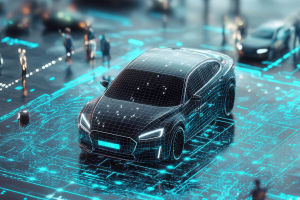Imagine gliding down the road in a car that runs quietly, emits no exhaust, and recharges simply by plugging in — that's the promise of electric vehicles (EVs).
But what exactly makes an electric car work beneath its sleek exterior?
Understanding the science behind electric cars reveals a fascinating blend of battery technology, electric motors, and smart control systems that together create a clean, efficient way to travel. Let's take a deep dive into how these vehicles operate, focusing on the heart of the system: batteries, motors, and their environmental benefits.
Batteries: The Energy Storehouses of Electric Cars
At the core of every electric car is a traction battery pack, usually made up of hundreds or thousands of individual lithium-ion cells. These batteries store electrical energy that powers the car's motor.
• How do they work? During charging, electrical energy flows into the battery, moving lithium ions from the cathode to the anode, where they are stored. When driving, the process reverses: lithium ions flow back, releasing electrons to power the motor.
• These batteries are designed to offer a balance between energy density (how much energy they hold), safety, longevity, and weight. Advances in battery chemistry have significantly improved how far EVs can travel on a single charge.
• To keep everything running safely and efficiently, a battery management system (BMS) monitors temperature, voltage, and state of charge to prevent overheating and maximize battery lifespan.
Electric Motors: Turning Electricity into Motion
Unlike traditional cars that run on internal combustion engines, EVs use electric traction motors that convert electrical energy directly into mechanical energy to turn the wheels.
• An electric motor relies on the principles of electromagnetism: when electric current passes through coils (stator), it creates a magnetic field that interacts with magnets on a rotating part (rotor), causing it to spin.
• This spinning rotor drives the car's wheels through a simple transmission.
• Electric motors deliver instant torque, meaning acceleration feels smooth and responsive from a standstill, unlike the delayed power buildup of gas engines.
• Many EVs use alternating current (AC) motors, powered by inverters that convert the battery's direct current (DC) to AC, controlling motor speed and torque precisely.
• When slowing down, the motor can reverse roles and act as a generator, regenerative braking, converting kinetic energy back into electricity to recharge the battery — enhancing efficiency.
Controllers and Power Electronics: The Brain of the EV
Between the battery and the motor lies the power electronics controller — think of it as the vehicle's brain.
• This unit regulates how much electrical power is sent to the motor, adjusting speed and torque based on driver input from the accelerator pedal.
• By changing the frequency and amplitude of the AC power sent to the motor, the controller achieves smooth acceleration and deceleration.
• It also manages energy recovery during braking and ensures that all components operate within safe electrical limits.
Charging: Plugging into a New Way to Fill Up
Electric cars recharge using Electric Vehicle Supply Equipment (EVSE) — commonly known as charging stations.
• Charging ports on the car connect to external power sources, supplying AC or DC electricity depending on the charger type.
• The onboard charger converts AC power into DC to replenish the battery.
• Charging speed varies by technology: from slow overnight charging with common household outlets to fast DC charging stations that can charge an EV to 80% capacity in around 30 minutes.
• As battery technology and infrastructure improve, charging becomes more convenient and efficient.
The Environmental Benefits: Driving Toward a Greener Future
Switching from gasoline engines to electric motors has profound environmental implications:
• No tailpipe emissions: EVs produce zero direct exhaust, reducing urban air pollution and improving public health.
• Higher efficiency: Electric motors convert a higher percentage of energy into motion compared to combustion engines, meaning less energy waste.
• Renewable synergy: When charged using electricity from renewable sources like solar or wind, EVs can operate with an exceptionally low carbon footprint.
• Reduced noise pollution: EVs run much quieter, contributing to more pleasant, less noisy cities and neighborhoods.
Experts highlight these benefits while noting continued advances in battery recycling and cleaner manufacturing methods are key to maximizing sustainability.
Your Role in the Electric Revolution
As electric vehicles become more common, what does that mean for everyday drivers?
• Understanding how EVs work can help you appreciate their maintenance perks—fewer moving parts mean less frequent servicing and lower running costs.
• Being mindful about charging habits, such as charging overnight or during off-peak hours, can also save money and reduce strain on power grids.
• As governments and companies expand charging infrastructure, owning an EV is becoming more practical for diverse lifestyles.
Imagining the Road Ahead
Electric vehicles are more than just new cars—they represent a shift toward sustainable transportation informed by innovative science and technology. From batteries storing power to motors transforming energy into smooth motion, EVs showcase how cutting-edge engineering addresses real-world environmental challenges.
What excites you most about the rise of electric vehicles? Are you considering making the switch or already enjoying the quiet ride? The journey to greener roads is accelerating, and understanding the science behind EVs puts you in the driver's seat of a cleaner future.
Would you like tips on choosing your first EV or advice on chargers and range management? Let's continue exploring the electric revolution together.


